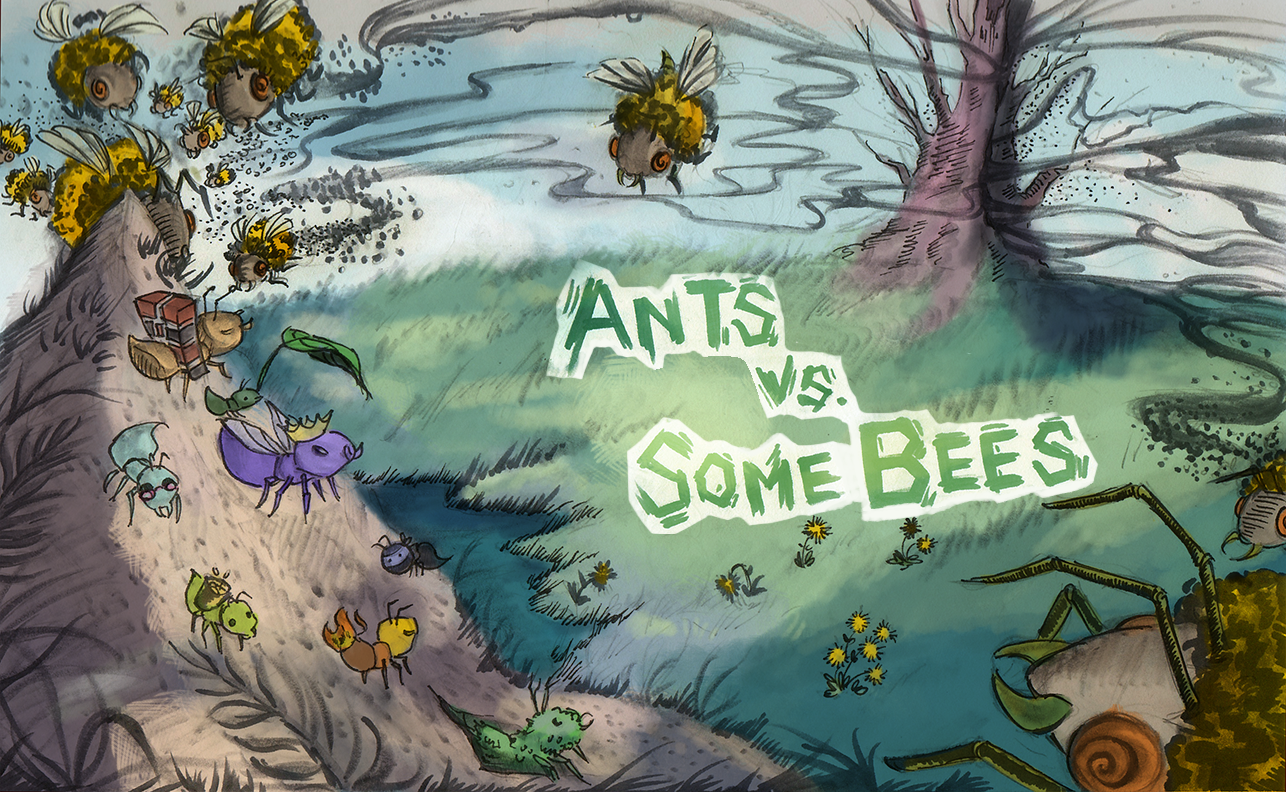

The bees are coming! Create a better soldier with inherit-ants.
To get started, download project materials project3.zip from our QQ group if you don't have one. Below is a list of all the files you will see in the project3.zip. However, you only have to make changes to ants/ants.py in this project.
project3
|-ants
| |-ants.py # The game logic of Ants Vs. SomeBees
| |-ants_gui.py # The original GUI for Ants Vs. SomeBees
| |-graphics.py # Utilities for displaying simple two-dimensional animations
| |-utils.py # Some functions to facilitate the game interface
| |-ucb.py # Utility functions from CS 61A
| |-assets # A directory of images and files used by gui.py
| |-img # A directory of images used by ants_gui.py
| |-ok # The autograder
| |-proj3.ok # The ok configuration file
| `-tests # A directory of tests used by ok
`-project3.pdf # Instructions for this project you must read
Important submission notes: This project has four phases. You have seven days for Phase 1&2 and seven more days for Phase 2&3. It doesn't mean that you are restricted to complete Phase 3&4 in just seven days. That is, you have 14 days in total for this project but the Phase 1&2 should be finished in the first 7 days. We recommend starting and finishing Phase 1&2 as soon as possible to give yourself adequate time to complete Phases 3&4, which can be more time consuming. Check the exact deadline on our OJ website.
After completing any problems required in each phase, you need to submit your answer to
Contest 'ants: phase 1&2'andContest 'ants: phase 3&4'correspondingly on our OJ website to get your answer scored. We recommend that you submit after you finish each problem so that you can find bugs as soon as possible.
In this project, you will create a tower defense game called Ants Vs. SomeBees. As the ant queen, you populate your colony with the bravest ants you can muster. Your ants must protect their queen from the evil bees that invade your territory. Irritate the bees enough by throwing leaves at them, and they will be vanquished. Fail to pester the airborne intruders adequately, and your queen will succumb to the bees' wrath. This game is inspired by PopCap Games' Plants Vs. Zombies.
This project combines functional and object-oriented programming paradigms, focusing on the material from Chapter 2.5 of Composing Programs. The project also involves understanding, extending, and testing a large program.
For the functions that we ask you to complete, there may be some initial code that we provide. If you would rather not use that code, feel free to delete it and start from scratch. You may also add new function definitions as you see fit.
However, please do not modify any other functions. Doing so may result in your code failing our framework. Also, please do not change any function signatures (names, argument order, or number of arguments).
A game of Ants Vs. SomeBees consists of a series of turns. In each turn, new bees may enter the ant colony. Then, new ants are placed to defend their colony. Finally, all insects (ants, then bees) take individual actions. Bees either try to move toward the end of the tunnel or sting ants in their way. Ants perform a different action depending on their type, such as collecting more food, or throwing leaves at the bees. The game ends either when a bee reaches the end of a tunnel (you lose), or the entire bee fleet has been vanquished (you win).
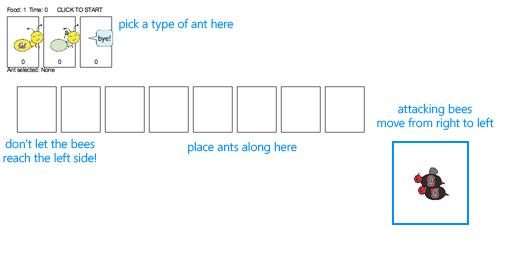
The Colony. This is where the game takes place. The colony consists of several places that are chained together to form a tunnel where bees can travel through. The colony has some quantity of food that can be expended to deploy ant troops.
Places. A place links to another place to form a tunnel. The player can place a single ant into each place. However, there can be many bees in a single place.
The Hive. This is the place where bees originate. Bees exit the beehive to enter the ant colony.
Ants. Ants are the usable troops in the game that the player places into the colony. Each type of ant takes a different action and requires a different amount of food to place. The two most basic ant types are the HarvesterAnt, which adds one food to the colony during each turn, and the ThrowerAnt, which throws a leaf at a bee each turn. You will be implementing many more.
Bees. Bees are the antagonistic troops in the game that the player must defend the colony from. Each turn, a bee either advances to the next place in the tunnel if no ant is in its way, or it stings the ant in its way. Bees win when at least one bee reaches the end of a tunnel.
The concepts described above each have a corresponding class that encapsulates the logic for that concept. Here is a summary of the main classes involved in this game:
GameState: Represents the colony and some state information about the game, including how much food is available, how much time has elapsed, where the QueenAnt resides, and all the Places in the game.Place: Represents a single place that holds insects. At most one Ant can be in a single place, but there can be many Bees in a single place. Place objects have an exit to the left and an entrance to the right which are also places. Bees travel through a tunnel by moving to a Place's exit.Hive: Represents the place where Bees start out (on the right of the tunnel).AntHomeBase: Represents the place Ants are defending (on the left of the tunnel). If Bees get here, they win :(Insect: A superclass for Ant and Bee. All insects have an armor attribute, representing their remaining health, and a place attribute, representing the Place where they are currently located. Each turn, every active Insect in the game performs its action.Ant: Represents ants. Each Ant subclass has special attributes or a special action that distinguish it from other Ant types. For example, a HarvesterAnt gets food for the colony and a ThrowerAnt attacks Bees. Each ant type also has a food_cost attribute that indicates how much it costs to deploy one unit of that type of ant.Bee: Represents bees. Each turn, a bee either moves to the exit of its current Place if no ant blocks its path, or stings an ant that blocks its path.Below is a visualization of an GameState. As you work through the unlocking tests and problems, we recommend drawing out similar diagrams to help your understanding.

The game can be run in two modes: as a text-based game or using a graphical user interface (GUI). The game logic is the same in either case, but the GUI enforces a turn time limit that makes playing the game more exciting. The text-based interface is provided for debugging and development.
The files are separated according to these two modes. ants.py knows nothing of graphics or turn time limits.
To start a text-based game, run
python ants_text.py
To start a graphical game, run
python ants_gui.py
When you start the graphical version, a new browser window should appear. In the starter implementation, you have unlimited food and your ants can only throw leaves at bees in their current Place. Try playing the game anyway! You'll need to place a lot of ThrowerAnts (the second type) in order to keep the bees from reaching your queen.
The game has several options that you will use throughout the project, which you can view with python ants_text.py --help
(or python ants_gui.py --help in GUI mode).
usage: ants_text.py [-h] [-d DIFFICULTY] [-w] [--food FOOD]
Play Ants vs. SomeBees
optional arguments:
-h, --help show this help message and exit
-d DIFFICULTY sets difficulty of game (test/easy/medium/hard/extra-hard)
-w, --water loads a full layout with water
--food FOOD number of food to start with when testing
Important submission notes: After completing any problems required in this phase, you need to submit your answer to
Contest 'ants: phase 1&2'on our OJ website to get your answer scored. Don't forget to check the deadline on the OJ website.
Before writing any code, let us introduce a new tool ok that is used in this project.
ok is an auto-grader that is designed to check your understanding of problems and test your code. It is distributed along with our project, so you can find it in the ants directory.
To use ok, you should open the terminal, cd to the ants directory, and then use the command like python ok --local <options>... to start ok. What does the --local option mean here? Well, ok has two modes: remote mode and local mode. The remote mode works like our OJ website where ok tests and grades your code remotely. The local mode works like doctest where ok tests your code locally. Since we have already had an OJ website, we just use the local mode in this project. Don't forget to add --local option when using ok. What would happen if you forgot it? Well, nothing, because we have changed the ok configuration file to suppress something bad.
If you forget how to use terminal or what the common format of commands is, please refer to
lab00.
Now the current procedure to do assignments with ok is as follows:
<problem>.python ok --local -q <problem> -u to unlock the test cases for the <problem> by answering the questions from ok. This step is used to check your understanding of the <problem> before you write any code. The test cases are locked at the beginning, so you couldn't test your code if you bypass this step.<problem>.python ok --local -q <problem> to test your code for the <problem>. If you didn't pass the tests, ok will show you some error messages such as which test case you failed. Fix your code in your text editor until the test passes.You may need some explanations for the commands we just mentioned:
--local option has been explained before.-q option is used to test a particular question. For example, -q 01 means testing problem 1 only, so you will not see any annoying unrelated errors from the test cases for the problems you have not completed. If -q is not used, it means testing all the problems in this project, which is somewhat like python -m doctest xxx.py used in the previous assignments. Therefore, you can use python ok --local to test your code all at once after you complete the project.-u is used to unlock them by answering the questions from ok before you can use -q to test your code. ok will guide you how to answer its questions.Don't worry! We will let you known which command you should use when you need it.
By the way, the test cases used by
okis placed in theants/testsdirectory.
Now, let's try out ok for the problem 0. First, read the entire ants.py file. Then, test your understanding and unlock test cases for the problem 0 by answering the questions from ok:
python ok --local -q 00 -u
If you cannot answer these questions, read the file again, consult the core concepts/classes sections above, or ask a question in the QQ group.
The problem 0 doesn't require writing any code, so you needn't do step 2-4 as described above. That is to say, you needn't write, test, and submit your code any further in this problem. In fact, problem 0 doesn't have any test cases as well. Therefore,
-uis just used to have you answer some questions and will not unlock any test cases here.
Before writing any code, read the instructions and test your understanding of the problem:
python ok --local -q 01 -u
First, add food costs and implement harvesters. Currently, there is no cost for deploying any type of Ant, and so there is no challenge to the game. You'll notice that Ant has a base food_cost of zero. Override this value in each of the subclasses listed below with the correct costs.
| Class | Food Cost | Armor | |
|---|---|---|---|
 |
HarvesterAnt |
2 | 1 |
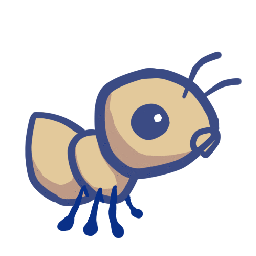 |
ThrowerAnt |
3 | 1 |
Now that deploying Ants cost food, we need to be able to gather more food! To fix this issue, implement the HarvesterAnt class. A HarvesterAnt is a type of Ant that adds one food to the gamestate.food total as its action.
After writing code, test your implementation:
python ok --local -q 01
Try playing the game by running python ants_gui.py. Once you have placed a HarvesterAnt, you should accumulate food each turn. You can also place ThrowerAnts, but you'll see that they can only attack bees that are in their Place, so it'll be a little difficult to win.
Before writing any code, read the instructions and test your understanding of the problem:
python ok --local -q 02 -u
Complete the Place constructor by adding code that tracks entrances. Right now, a Place keeps track only of its exit. We would like a Place to keep track of its entrance as well. A Place needs to track only one entrance. Tracking entrances will be useful when an Ant needs to see what Bees are in front of it in the tunnel.
However, simply passing an entrance to a Place constructor will be problematic; we would need to have both the exit and the entrance before creating a Place! (It's a chicken or the egg problem.) To get around this problem, we will keep track of entrances in the following way instead. The Place constructor should specify that:
Place always starts with its entrance as None.Place has an exit, then the exit's entrance is set to that Place.Hint: Remember that when the
__init__method is called, the first parameter,self, is bound to the newly created object.
Hint: Try drawing out two
Places next to each other if things get confusing. In the GUI, a place'sentranceis to its right while theexitis to its left.
After writing code, test your implementation:
python ok --local -q 02
Before writing any code, read the instructions and test your understanding of the problem:
python ok --local -q 03 -u
In order for a ThrowerAnt to attack, it must know which bee it should hit. The provided implementation of the nearest_bee method in the ThrowerAnt class only allows them to hit bees in the same Place. Your job is to fix it so that a ThrowerAnt will throw_at the nearest bee in front of it that is not still in the Hive.
The nearest_bee method returns a random Bee from the nearest place that contains bees. Places are inspected in order by following their entrance attributes.
Place of the ThrowerAnt.entrance.None.Hint: The
random_or_nonefunction provided inants.pyreturns a random element of a sequence or None if the sequence is empty.
Hint: Having trouble visualizing the test cases? Try drawing them out on paper! The example diagram provided in Game Layout shows the first test case for this problem.
After writing code, test your implementation:
python ok --local -q 03
After implementing nearest_bee, a ThrowerAnt should be able to throw_at a Bee in front of it that is not still in the Hive. Make sure that your ants do the right thing! To start a game with ten food (for easy testing):
python ants_gui.py --food 10
Now that you've implemented basic gameplay with two types of Ants, let's add some flavor to the ways ants can attack bees. In this phase, you'll be implementing several different Ants with different offensive capabilities.
After you implement each Ant subclass in this section, you'll need to set its implemented attribute to True so that that type of ant will show up in the GUI. Feel free to try out the game with each new ant to test the functionality!
With your Phase 2 ants, try python ants_gui.py -d easy to play against a full swarm of bees in a multi-tunnel layout and try -d normal, -d hard, or -d extra-hard if you want a real challenge! If the bees are too numerous to vanquish, you might need to create some new ants.
Before writing any code, read the instructions and test your understanding of the problem:
python ok --local -q 04 -u
The ThrowerAnt is a great offensive unit, but it'd be nice to have a cheaper unit that can throw. Implement two subclasses of ThrowerAnt that are less costly but have constraints on the distance they can throw:
LongThrower can only throw_at a Bee that is found after following at least 5 entrance transitions. It cannot hit Bees that are in the same Place as it or the first 4 Places in front of it. If there are two Bees, one too close to the LongThrower and the other within its range, the LongThrower should throw past the closer Bee, instead targeting the farther one, which is within its range.ShortThrower can only throw_at a Bee that is found after following at most 3 entrance transitions. It cannot throw at any ants further than 3 Places in front of it.Neither of these specialized throwers can throw_at a Bee that is exactly 4 Places away.
| Class | Food Cost | Armor | |
|---|---|---|---|
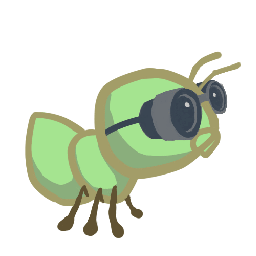 |
ShortThrower |
2 | 1 |
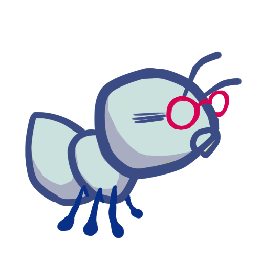 |
LongThrower |
2 | 1 |
A good way to approach the implementation to ShortThrower and LongThrower is to have it inherit the nearest_bee method from the base ThrowerAnt class. The logic of choosing which bee a thrower ant will attack is essentially the same, except the ShortThrower and LongThrower ants have maximum and minimum ranges, respectively.
To implement these behaviors, you will need to modify the nearest_bee method to reference min_range and max_range attributes, and only return a bee that is in range.
Make sure to give these min_range and max_range sensible defaults in ThrowerAnt that do not change its behavior. Then, implement the subclasses LongThrower and ShortThrower with appropriately constrained ranges and correct food costs.
Hint:
float('inf')returns an infinite positive value represented as a float that can be compared with other numbers.
Don't forget to set the implemented class attribute of LongThrower and ShortThrower to True.
Note! Please make sure your attributes are called
max_rangeandmin_rangerather thanmaximum_rangeandminimum_rangeor something. The tests directly reference this variable name.
After writing code, test your implementation (rerun the tests for 03 to make sure they still work):
python ok --local -q 03
python ok --local -q 04
Before writing any code, read the instructions and test your understanding of the problem:
python ok --local -q 05 -u
Implement the FireAnt, which does damage when it receives damage. Specifically, if it is damaged by armor armor units, it does a damage of armor to all bees in its place (this is called reflected damage).
If it dies, it does an additional amount of damage, which is specified by its damage attribute (by default 3).
To implement this, we have to override the FireAnt's reduce_armor method. Normally, Insect.reduce_armor will decrement the insect's armor by the given amount and remove the insect from its place if armor reaches zero or lower. However, FireAnt also does damage to all the bees in its place when it receives damage, with a special bonus when its armor drops to 0, before being removed from its place.
| Class | Food Cost | Armor | |
|---|---|---|---|
 |
FireAnt |
5 | 3 |
Hint: To damage a
Bee, call thereduce_armormethod inherited fromInsect.Hint: Damaging a bee may cause it to be removed from its place. If you iterate over a list, but change the contents of that list at the same time, you may not visit all the elements. This can be prevented by making a copy of the list. You can either use a list slice, or use the built-in
listfunction.
Once you've finished implementing the FireAnt, give it a class attribute implemented with the value True.
Note, even though you are overriding the
Insect.reduce_armorfunction, you can still use it in your implementation by calling it directly (rather than viaself). Note that this is not recursion (why?)
After writing code, test your implementation:
python ok --local -q 05
You can also test your program by playing a game or two! A FireAnt should destroy all co-located Bees when it is stung. To start a game with ten food (for easy testing):
python ants_gui.py --food 10
Before writing any code, read the instructions and test your understanding of the problem:
python ok --local -q 06 -u
Implement the HungryAnt, which will select a random Bee from its place and eat it whole. After eating a Bee, it must spend 3 turns digesting before eating again. If there is no bee available to eat, it will do nothing.
| Class | Food Cost | Armor | |
|---|---|---|---|
 |
HungryAnt |
4 | 1 |
Give HungryAnt a time_to_digest class attribute that holds the number of turns that it takes a HungryAnt to digest (default to 3). Also, give each HungryAnt an instance attribute digesting that counts the number of turns it has left to digest (default is 0, since it hasn't eaten anything at the beginning).
Implement the action method of the HungryAnt to check if it is digesting; if so, decrement its digesting counter. Otherwise, eat a random Bee in its place by reducing the Bee's armor to 0 and restart the digesting timer.
After writing code, test your implementation:
python ok --local -q 06
Before writing any code, read the instructions and test your understanding of the problem:
python ok --local -q 07 -u
Implement the NinjaAnt, which damages all Bees that pass by, but can never be stung.
| Class | Food Cost | Armor | |
|---|---|---|---|
 |
Ninja |
5 | 1 |
A NinjaAnt does not block the path of a Bee that flies by. To implement this behavior, first modify the Ant class to include a new class attribute blocks_path that is True by default. Set the value of blocks_path to False in the NinjaAnt class.
Second, modify the Bee's method blocked to return False if either there is no Ant in the Bee's place or if there is an Ant, but its blocks_path attribute is False. Now Bees will just fly past NinjaAnts.
Finally, we want to make the NinjaAnt damage all Bees that fly past. Implement the action method in NinjaAnt to reduce the armor of all Bees in the same place as the NinjaAnt by its damage attribute. Similar to the FireAnt, you must iterate over a list of bees that may change.
Hint: Having trouble visualizing the test cases? Try drawing them out on paper! See the example in Game Layout for help.
After writing code, test your implementation:
python ok --local -q 07
For a challenge, try to win a game using only HarvesterAnt and NinjaAnt.
Congratulations! You have finished Phases 1 and 2 of this project!
Important submission notes: After completing any problems required in the following two phases, you need to submit your answer to
Contest 'ants: phase 3&4'on our OJ website to get your answer scored. Don't forget to check the deadline on the OJ website.
We now have some great offensive troops to help vanquish the bees, but let's make sure we're also keeping our defensive efforts up. In this phase you will implement ants that have special defensive capabilities such as increased armor and the ability to protect other ants.
Before writing any code, read the instructions and test your understanding of the problem:
python ok --local -q 08 -u
We are going to add some protection to our glorious home base by implementing the WallAnt, which is an ant that does nothing each turn. A WallAnt is useful because it has a large armor value.
| Class | Food Cost | Armor | |
|---|---|---|---|
 |
WallAnt |
4 | 4 |
Unlike with previous ants, we have not provided you with a class header. Implement the WallAnt class from scratch. Give it a class attribute name with the value 'Wall' (so that the graphics work) and a class attribute implemented with the value True (so that you can use it in a game).
After writing code, test your implementation:
python ok --local -q 08
Before writing any code, read the instructions and test your understanding of the problem:
python ok --local -q 09 -u
Right now, our ants are quite frail. We'd like to provide a way to help them last longer against the onslaught of the bees. Enter the BodyguardAnt.
| Class | Food Cost | Armor | |
|---|---|---|---|
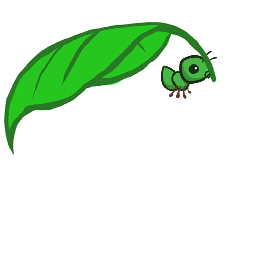 |
BodyguardAnt |
4 | 2 |
A BodyguardAnt differs from a normal ant because it is a ContainerAnt; it can contain another ant and protect it, all in one Place. When a Bee stings the ant in a Place where one ant contains another, only the container is damaged. The ant inside the container can still perform its original action. If the container perishes, the contained ant still remains in the place (and can then be damaged).
Each ContainerAnt has an instance attribute contained_ant that stores the ant it contains. It initially starts off as None, to indicate that no ant is being protected. Implement the contain_ant method so that it sets the bodyguard's contained_ant instance attribute to the passed in ant argument. Also implement the ContainerAnt's action method to perform its contained_ant's action if it is currently containing an ant.
In addition, you will need to make the following modifications throughout your program so that a container and its contained ant can both occupy a place at the same time (a maximum of two ants per place), but only if exactly one is a container:
ContainerAnt.can_contain which takes an other ant as an argument and returns True if:Ant.can_contain returns False by default; it needs to be overridden in ContainerAnt.Ant.add_to to allow a container and a non-container ant to occupy the same place according to the following rules:BodyguardAnt.__init__ that changes the default amount of armor.Hint: You may find the
isinstancefunction useful for checking if an object is an instance of a given class. For example:
Note: the constructor of
ContainerAnt.__init__is implemented as suchAs we saw in Hog, we have that
argsis bound to all positional arguments (that is all arguments not passed not with keywords, andkwargsis bound to all the keyword arguments. This ensures that both sets of arguments are passed to the Ant constructor).Effectively, this means the constructor is exactly the same as
Ant.__init__but setsself.contained_ant = None
After writing code, test your implementation:
python ok --local -q 09
Before writing any code, read the instructions and test your understanding of the problem:
python ok --local -q 10 -u
The BodyguardAnt provides great defense, but they say the best defense is a good offense. The TankAnt is a container that protects an ant in its place and also deals 1 damage to all bees in its place each turn.
| Class | Food Cost | Armor | |
|---|---|---|---|
 |
TankAnt |
6 | 2 |
You should not need to modify any code outside of the TankAnt class. If you find yourself needing to make changes elsewhere, look for a way to write your code for the previous question such that it applies not just to BodyguardAnt and TankAnt objects, but to container ants in general.
After writing code, test your implementation:
python ok --local -q 10
In the final phase, you're going to add one last kick to the game by introducing a new type of place and new ants that are able to occupy this place. One of these ants is the most important ant of them all: the queen of the colony.
Before writing any code, read the instructions and test your understanding of the problem:
python ok --local -q 11 -u
Let's add water to the colony! Currently there are only two types of places, the Hive and a basic Place. To make things more interesting, we're going to create a new type of Place called Water.
Only an ant that is watersafe can be deployed to a Water place. In order to determine whether an Insect is watersafe, add a new attribute to the Insect class named is_watersafe that is False by default. Since bees can fly, make their is_watersafe attribute True, overriding the default.
Now, implement the add_insect method for Water. First, add the insect to the place regardless of whether it is watersafe. Then, if the insect is not watersafe, reduce the insect's armor to 0. Do not repeat code from elsewhere in the program. Instead, use methods that have already been defined.
After writing code, test your implementation:
python ok --local -q 11
Once you've finished this problem, play a game that includes water. To access the wet_layout which includes water, add the --water option (or -w for short) when you start the game.
python ants_gui.py --water
Before writing any code, read the instructions and test your understanding of the problem:
python ok --local -q 12 -u
Currently there are no ants that can be placed on Water. Implement the ScubaThrower, which is a subclass of ThrowerAnt that is more costly and watersafe, but otherwise identical to its base class. A ScubaThrower should not lose its armor when placed in Water.
| Class | Food Cost | Armor | |
|---|---|---|---|
 |
ScubaThrower |
6 | 1 |
We have not provided you with a class header. Implement the ScubaThrower class from scratch. Give it a class attribute name with the value 'Scuba' (so that the graphics work) and remember to set the class attribute implemented with the value True (so that you can use it in a game).
After writing code, test your implementation:
python ok --local -q 12
Before writing any code, read the instructions and test your understanding of the problem:
python ok --local -q 13 -u
Finally, implement the QueenAnt. The queen is a waterproof ScubaThrower that inspires her fellow ants through her bravery. In addition to the standard ScubaThrower action, the QueenAnt doubles the damage of all the ants behind her each time she performs an action. Once an ant's damage has been doubled, it is not doubled again for subsequent turns.
Note that the reflected damage of a fire ant should not be doubled, only the extra damage it deals when its armor is reduced to 0
| Class | Food Cost | Armor | |
|---|---|---|---|
 |
QueenAnt |
7 | 1 |
However, with great power comes great responsibility. The QueenAnt is governed by three special rules:
bees_win() to signal to the simulator that the game is over.Ant.remove_from in QueenAnt to enforce this condition.Some hints:
QueenAnt instance is the true QueenAnt?Place in a tunnel behind the QueenAnt by starting at the ant's place.exit and then repeatedly following its exit. The exit of a Place at the end of a tunnel is None.QueenAnt.action.After writing code, test your implementation:
python ok --local -q 13
Note: This problem is a bit difficult, so we make it optional. However, we recommend you to try to solve it if you have time because it is fun. You don't have to submit your code for this problem to our OJ website.
Before writing any code, read the instructions and test your understanding of the problem:
python ok --local -q OPTIONAL -u
Implement two final thrower ants that do zero damage, but instead produce a temporary "effect" on the action method of a Bee instance that they throw_at. This effect is an alternative action that lasts for a certain number of .action(gamestate) calls, after which the Bee's action reverts to its previous behavior.
We will be implementing two new ants that subclass ThrowerAnt.
SlowThrower throws sticky syrup at a bee, applying a slow effect for 3 turns.ScaryThrower intimidates a nearby bee, causing it to back away instead of advancing. (If the bee is already right next to the Hive and cannot go back further, it should not move.) The scare effect lasts for 2 turns. Once a bee has been scared once, it can't be scared again.| Class | Food Cost | Armor | |
|---|---|---|---|
 |
SlowThrower |
4 | 1 |
 |
ScaryThrower |
6 | 1 |
In order to complete the implementations of these two ants, you will need to set their class attributes appropriately and implement the following three functions:
make_slow is an effect that takes an action method and a bee, and returns a new action method that performs the original action on every turn that gamestate.time is even and does nothing on other turns.make_scare is an effect that takes an action method and a bee, and returns a new action method that makes the bee go backwards.apply_effect takes an effect (either make_slow or make_scare), a Bee, and a duration. The way it works is as so: imagine that a Bee has a bunch of effects, each of which modifies action in sequence. When an effect's duration is up, it removes itself from the list. apply_effect adds the given effect to the end of the list, so that it is applied latest.Hint: to make a bee go backwards, consider adding an instance variable indicating its current direction. Where should you change the bee's direction? Once the direction is known, how can you modify the
actionmethod ofBeeto move appropriately?Hint: You will need to rebind a method in one of the functions. Note that when assigning to an instance, the self parameter isn't bound.
As an example of what "previous behavior" means, take the example of a bee that has been slowed twice (say by two separate SlowThrowers). It will have the following behavior
- on time 1, it will do nothing. The outer slow has 2 turns to go, the inner one still has 3 turns
- on time 2, it moves forward. The outer slow has 1 turn to go, the inner one has 2 turns
- on time 3, it will do nothing. The outer slow has no turns left, the inner one has 2 turns
- on time 4, it moves forward. The inner slow has 1 turn left
- on time 5, it does nothing. The inner slow has no turns left
You can run some provided tests, but they are not exhaustive:
python ok --local -q OPTIONAL
Make sure to test your code! Your code should be able to apply multiple effects on a target; each new effect applies to the current (possibly affected) action method of the bee.
You are now done with the project! If you haven't yet, you should try playing the game!
python ants_gui.py [-h] [-d DIFFICULTY] [-w] [--food FOOD]
Acknowledgments to cs61A: Tom Magrino and Eric Tzeng developed this project with John DeNero. Jessica Wan contributed the original artwork. Joy Jeng and Mark Miyashita invented the queen ant. Many others have contributed to the project as well!
The new concept artwork was drawn by Alana Tran, Andrew Huang, Emilee Chen, Jessie Salas, Jingyi Li, Katherine Xu, Meena Vempaty, Michelle Chang, and Ryan Davis.